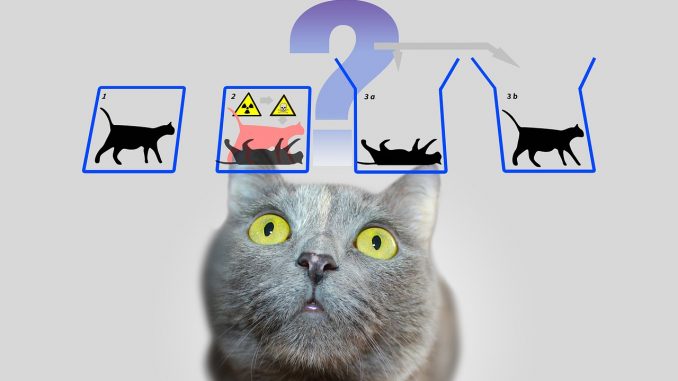Reading Time – 4 minutes, Difficulty Level 1/5
You may have heard of Schrödinger’s Cat, unique thought experiment designed by Erwin Schrödinger in 1935 to illustrate the strange behaviour of subatomic particles.
It’s not a real experiment so don’t worry about injuring any furry friends! It’s simply a way for us to try and understand how these tiny particles behave using a hypothetical situation that’s easier for us to picture in our minds.
Here, there, everywhere
Quantum theory tells us that until we observe or measure a subatomic particle, it exists in all the states it could possibly exist in, at the same time.

Image credit: Stuart, et al. ©2012 American Physical Society
This means that there is some probability of it being in one place, but also a probability of higher than zero that it could be in one or more other places. We would describe this particle as being in quantum superposition.
When a physical act of measurement or observation is carried out and we look at the particle, it’s superposition collapses and it chooses a fixed position. The act of observing the particle actually influences it.
Not the obvious
When I have previously described this to others I often get a common rebuttal; “The particle was always in that position, you just didn’t know it was until you looked”.
That’s a very reasonable push back, however it’s not that simple! There are some very interesting experiments, such as the ‘double slit experiment’ which prove that isn’t the case. Read up on them for yourself.
Feline intervention
Schrödinger wanted to find a way to illustrate this strange reality and came up with a unique thought experiment to do just that.
He suggested we imagine a box. Inside that box we put a cat and a radioactive source with a 50% chance of decaying and consequently killing the cat. We close the lid.
In this state we do not know if the radioactive source has killed the cat or not. In order to find that out, we have to open the box and look.
This puts the cat in superposition. It must exist in all the states it possibly can until it is observed when the box is opened.
The cat is both alive and dead at the same time.
Big versus small
That sounds ludicrous. We all know the cat is either alive or dead before we open the box and our observation of it has no bearing on the outcome.
That is the way we think of the world and its true for large objects like cats, but absolutely untrue in the subatomic world.
The Schrödinger’s cat thought experiment is designed to illustrate just how bizarre quantum superposition is. It may not apply to cats but it most certainly does apply to those tiny particles we observe that make up cats and everything else in our universe.
Weird huh?
I’m the founder of The Average Scientist and also an Astrophysicist, a passionate Science Communicator and elected Fellow of the Royal Astronomical Society.
I regularly speak at various events, including our TAS Talks and theatre shows on subjects such as Astrophysics, Planetary Science and the Evolution of the Universe.








